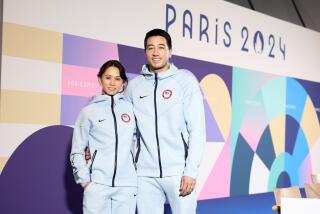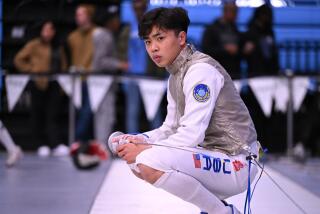He Cuts . . . He Slashes . . . He Makes a Point : Spence Thompson, Fencer, Foils Notion That Winning Athletes Must Be Huge, Mean
- Share via
Spense Thompson is normally quiet and composed, but he can get the point across rather quickly.
Like a 20th-Century D’Artagnan, Thompson attacks his rivals with brio, searching for an opportunity to strike.
When he hits, he usually wins.
Thompson, 15, is a fencer at Harvard High in Studio City. In only three years, the sophomore has become one of the nation’s best in his age group, despite a slow start in a sport he knew little about.
“It’s individual, I like that,” Thompson said recently with characteristic reserve. “There’s no one thing I can pinpoint.”
Last month, Thompson was unbeaten in 18 matches to claim the epee championship for athletes under 16 in the U.S. Fencing Assn. Junior Olympics. Thompson competed against about 50 contenders.
Two other Harvard fencers, John DeShazo and Buck Robinson, also did well in the Cleveland, Ohio, tournament. DeShazo took 18th in saber competition; Robinson was 22nd in the foil.
While the sport--which is not sanctioned by the CIF--enjoys a wide following at East Coast prep schools, it is still considered a minor sport in the west, a designation that troubles third-year Harvard fencing instructor Theodore Katzoff.
“For someone interested in the growth and the development of the sport, I find that unfortunate,” Katzoff said during an afternoon practice session at Harvard. “Fencing is one of the many minor sports that doesn’t bring income.”
Katzoff holds down five coaching jobs to pay his bills. Besides Harvard, he also coaches at UCLA, Occidental College, Oakwood School and at his own fencing center in Culver City.
“I can’t be full-time at one place,” Katzoff said. “I would starve.”
It’s worse for students. According to Katzoff, there are no college fencing scholarships on the West Coast.
That has not stifled interest at Harvard.
Katzoff said there are 50 students in his fencing classes, which are offered as regular physical education courses.
The fencing hall, a small bungalow surrounded by a student parking lot, looks like a well-kept shed amid amid the modern buildings on Harvard’s campus.
Inside in the early afternoon, between three dozen swords attached to the wall by clothes pins and two dozen fencing helmets hanging on hooks, are Katzoff, Thompson and the rest of the class doing warm-ups.
“Be mobile!” Katzoff urged two of his students as they maneuvered for position. “This is a sport of tremendous mobility.”
Fencers duel in an area called a terrain, which is 2 meters wide and 16 meters long. Preliminary matches are round robins that end after five hits against an opponent.
Fair target for the foil is the torso. For the epee--a heavier, 17th century weapon--all parts of the body are fair. The saber, however, is a cutting as well as thrusting weapon. Hits may be scored in either manner from the waist up.
Thompson started with a lesson on those basics in that tiny, white, nearly airless room.
“I began very poorly to say the least,” he said quietly. “You just have to start from zero. It took a long time just to get going.”
To maintain his success has taken five days of practice a week for Thompson--three at Harvard and two at a private facility.
“I really don’t have time for anything else,” he said.
The practice has produced results.
Because of his win in Cleveland, Thompson was invited to the National Sports Festival in Baton Rouge, La., July 22 through August 4. Only the top two epee fencers in his age group nationally were invited.
Thompson’s calm nature complements his fencing abilities, and both have helped him to be successful.
“He’s a little unusual that way,” said Katzoff, who thinks many of his young fencers are too high-strung to be successful in the sport.
Not unusual was the way Thompson got involved with the sport. He heard about it on campus, got curious, and casually dropped by a class to take a look.
Katzoff, who holds a master’s degree in theater arts, said there is more to fencing than just winning matches and tournaments.
“It’s a sport of honor, tradition and respect,” he said. “My biggest reward is being associated with the fine kids and adults who study fencing.”
Although Thompson has not of yet decided on a college or university, an important consideration will be a strong fencing program. Local possibilities in that category include Stanford, UC Santa Barbara and the California Institute of Technology.
In another three years, that quick peek inside Harvard’s little bungalow just might land Thompson a spot on a future U.S. Olympic team, although only the fencers who are consistently among the top six nationally in saber, foil and epee are chosen.
“It’s a tough goal,” Thompson said.
Touche.
More to Read
Go beyond the scoreboard
Get the latest on L.A.'s teams in the daily Sports Report newsletter.
You may occasionally receive promotional content from the Los Angeles Times.






